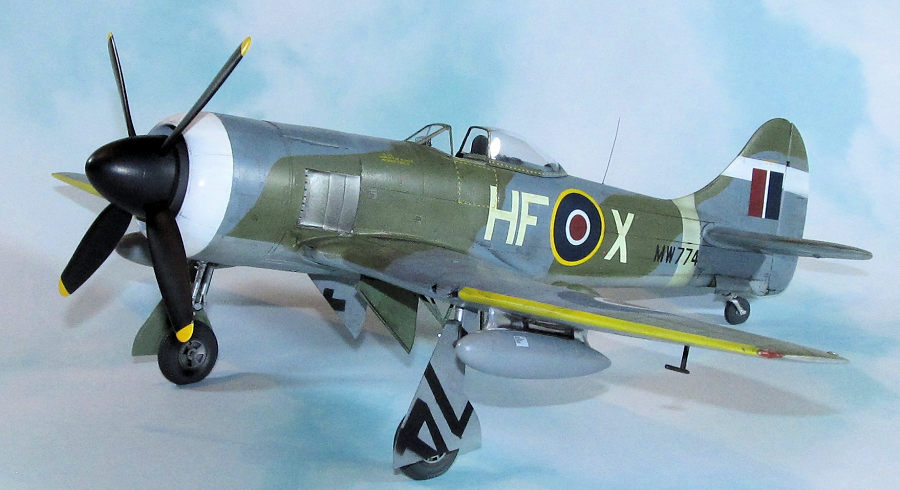
Special Hobby 1/32 Tempest II
| KIT #: | SH 32054 |
| PRICE: | $85.00 or so |
| DECALS: | Five options |
| REVIEWER: | Dan Lee |
| NOTES: | Hi Tech boxing. A LOT OF PARTS. Maktar Masking Set used. |

| HISTORY |
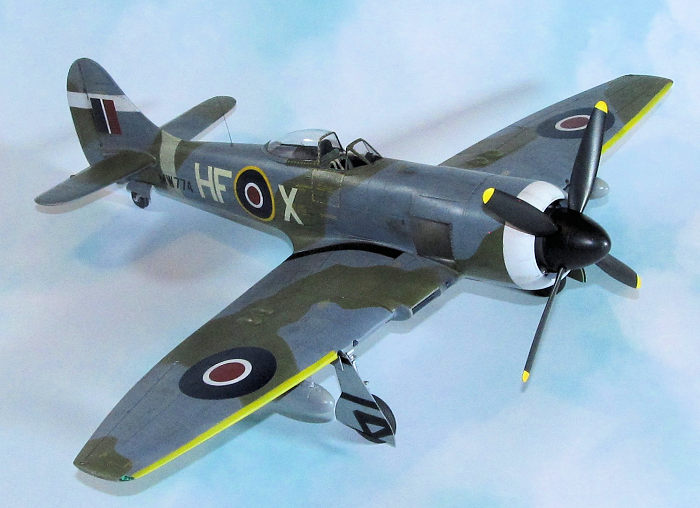 mechanical
issues with engine vibration, cooling issues, crankshaft lubrication, exhaust
malfunctions and reduction gear failures which were eventually corrected, but
helped delay production of the Mk II. The immediate need in the European Theatre
of Operations meant the Tempest Mk V was given priority in production over the
Mk II as the Mk II was meant to be sent to the Pacific. The first batches of the
Tempest II did not leave the production line until October 1944 and it was
expected that the first Tempest II equipped wing would be assigned to Tiger
Force which would be ready to leave for the Pacific in May 1945. The surrender
of Japan in Aug of 1945 brought about a change in procurement and only a total
of 452 Tempest II airframes were built with 300 delivered after the war. The RAF
was not in a hurry to introduce the new fighter to its peace-time service so the
only unit to be equipped with these machines in 1945 was no. 54 Sqn. Later there
were another six squadrons that operated the Tempest II located in Germany and
India. Following the declaration of independence of India and Pakistan, India
received 85 Tempest IIs from the RAF stocks and Pakistan got another 24
airframes.
mechanical
issues with engine vibration, cooling issues, crankshaft lubrication, exhaust
malfunctions and reduction gear failures which were eventually corrected, but
helped delay production of the Mk II. The immediate need in the European Theatre
of Operations meant the Tempest Mk V was given priority in production over the
Mk II as the Mk II was meant to be sent to the Pacific. The first batches of the
Tempest II did not leave the production line until October 1944 and it was
expected that the first Tempest II equipped wing would be assigned to Tiger
Force which would be ready to leave for the Pacific in May 1945. The surrender
of Japan in Aug of 1945 brought about a change in procurement and only a total
of 452 Tempest II airframes were built with 300 delivered after the war. The RAF
was not in a hurry to introduce the new fighter to its peace-time service so the
only unit to be equipped with these machines in 1945 was no. 54 Sqn. Later there
were another six squadrons that operated the Tempest II located in Germany and
India. Following the declaration of independence of India and Pakistan, India
received 85 Tempest IIs from the RAF stocks and Pakistan got another 24
airframes.
(Copied from the Special Hobby Website and edited for corrections, clarity and simplicity.)
| THE KIT |
 The Tempest
II kit which I purchased is the Hi-Tech version which contains various resin and
photo-etch parts plus the original plastic. There is a lot to unpack in this kit
as there are well over 300 parts in a grey plastic on nine plastic sprues, one
clear plastic sprue, one baggie full of resin bits including two different types
of wheels, one PE sheet, one HGW fabric seatbelt sheet, one acetate sheet, one
sheet of vinyl masks and finally four decal sheets with insignia/stencils/black
lettering/interior and miscellaneous decals. The baggie contains resin parts for
the cockpit, wheels and an optional exposed port side wing interior.
The Tempest
II kit which I purchased is the Hi-Tech version which contains various resin and
photo-etch parts plus the original plastic. There is a lot to unpack in this kit
as there are well over 300 parts in a grey plastic on nine plastic sprues, one
clear plastic sprue, one baggie full of resin bits including two different types
of wheels, one PE sheet, one HGW fabric seatbelt sheet, one acetate sheet, one
sheet of vinyl masks and finally four decal sheets with insignia/stencils/black
lettering/interior and miscellaneous decals. The baggie contains resin parts for
the cockpit, wheels and an optional exposed port side wing interior.
The plastic is grey and flash free with many finely detailed plastic parts. There are a lot of surplus parts because there are many parts for the Tempest V and VI kits including chin radiator detail. Also a lot of extra cockpit and wheel parts if you use the resin parts.
Unless you want to open up the cowling and show off the Centaurus engine then the kit has pretty much everything needed for most experienced modellers.
| CONSTRUCTION |
The work on this kit began with the forward engine compartment and propeller. The engine cowling was assembled using the early top cover (without the vent) and bottom with the seams held together using CA glue to deal with phantom seams as well as the fill in very noticeable gaps in the interior lip of the cowl. The fit wasn't all that great so I ended up sanding the edges of the pieces to improve the fit (I would find out later that I didn't do as good a job as I thought.) Several bouts of sanding and filling were required before the interior of the cowling and outside seams were dealt with to my satisfaction.
Meanwhile the prop and engine face were painted. I didn't mind the simplified engine face as I don't usually open up the engine compartment and most of the engine detail is hidden by the large prop and narrow cowling opening. Both subassemblies were primed using Black Stynylrez primer. I brush painted the engine cylinders Vallejo Metal Color Magnesium and Tamiya Metallic Grey. The prop blade tips were masked off on the forward facing side then sprayed flat white then flat yellow and then repeated for the rear facing side while interior of the cowling was sprayed Tamiya Medium Sea Grey. The prop is mounted to a bushing and rotates on a plate that glues to the engine face. The bushing was painted silver as per instructions and I carefully glued the plate to the prop shaft which allowed it to spin.
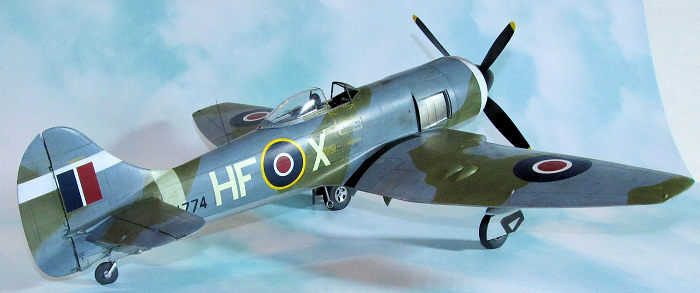 Once the
interior paint was dry, I masked off the interior and then sprayed on flat white
around the exterior surface of the cowling. The next day, I masked off the white
ring around the cowling while I inserted the engine face as well as exhaust
pipes underneath which had been drilled out.
Once the
interior paint was dry, I masked off the interior and then sprayed on flat white
around the exterior surface of the cowling. The next day, I masked off the white
ring around the cowling while I inserted the engine face as well as exhaust
pipes underneath which had been drilled out.
Next I tackled the cockpit which is almost a model in itself. This particular boxing comes with both an option for resin pieces or the less detailed plastic ones. I chose the resin pieces as I enjoy making things difficult for myself. The various resin and plastic pieces were primed first then pre painted on the sprue flat black or Tamiya XF-71 Cockpit Green. When the paint was dry, I added the many decals for stencils and instruments. I used MicroSol as the initial setting solution and then the next day followed up with Solvaset to make things more permanent. The pieces were then cut away from the sprue or casting block and glued together with some small touchups with a brush required.
The resin seat was painted
as per instructions while I used the kit supplied fabric and PE seatbelts from
HGW. This was my first time using fabric and Photo-etch belt buckles and it took
a couple of hours of work to assemble the various straps. I think I did an okay
job with them and they do look much more realistic than PE seatbelts, but
dealing with the eye strain plus pins and needles from sleeping feet and a sore
butt gave me pause. For 1/32 they're the right size for my middle aged eyes, but
I'd be loathe to do 1/48 versions of them. Almost made me mi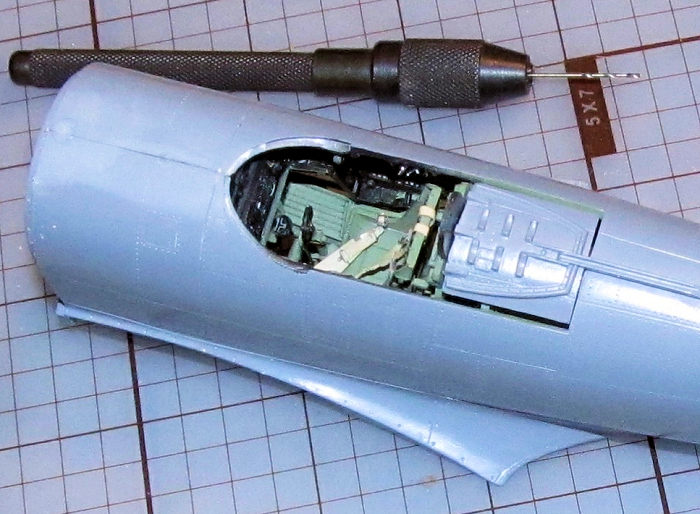 ss
“simple” PE seat belts.
ss
“simple” PE seat belts.
The various interior components were added to the fuselage and it was glued together using CA glue on the visible seams and Tamiya extra thin everywhere else. It was the first time with a Special Hobby kit where I didn't have to fight to seal the fuselage up (having built five Special Hobby kits previously.) Everything lined as it was supposed to. I sanded/polished the seams smooth (using 220/400/1000/1500 grit wet dry sandpaper) and replaced the detail etched using a needle in a pin vice (for the panel lines) and added the rivets using a ponce wheel. At this point things were going really well and I thought I would be able to finish this kit within a month. Well, that was till I started working on the wings and wheel wells.
It was then that I realized what the few reviews I read mentioned the issues with getting the wing and wheel well pieces to fit. First of all the wheel well pieces don't line up exactly and get worse when the wing is closed up. It seems that one of the parts is too big and needs to be trimmed. I trimmed H39 and H40 on one side to get them to fit with the wing without moving. This allows the landing gear mounts to seat properly. The landing gear and wheel well were the most complex and headache filled part of the build. It took me a couple of tries to get the port wing to line up and it still didn't work out because the top piece is not aligned properly. It took a month (on and off with work heating up) to get the wings assembled. Even so the top part of the port wing does not line up and required some work with a round file to make the cannon openings round instead of misaligned.
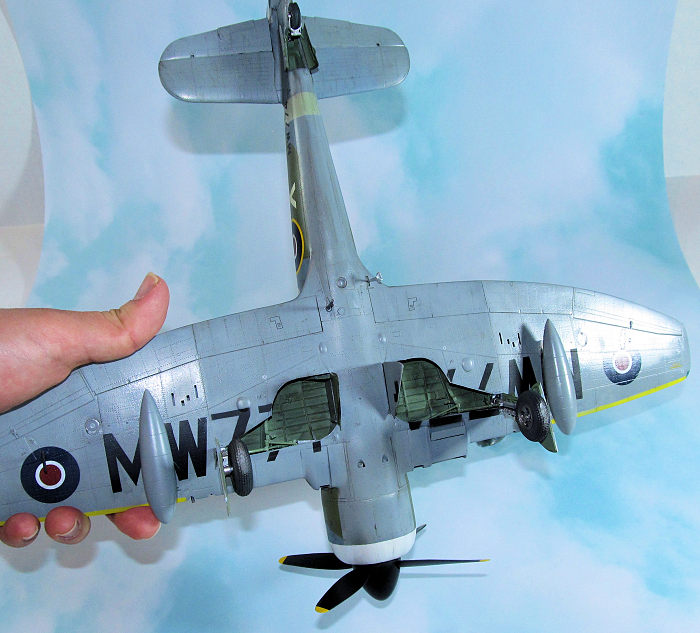 The Hi-Tech
version of the kit gives you an option for an opened up resin/PE open cannon
bay. I'm glad I avoided it as the headaches just assembling the port wing would
be made 100X worse for me if I had added the resin interior.
The Hi-Tech
version of the kit gives you an option for an opened up resin/PE open cannon
bay. I'm glad I avoided it as the headaches just assembling the port wing would
be made 100X worse for me if I had added the resin interior.
I assembled the wing intakes and they didn't line up with the wing all that great either. I figured I would just fill in the large open gaps with putty and be done with it. Attaching the wing to the fuselage wasn't that good either. I had to adjust the wings and fuselage several times and it wasn't till I got a fit that was just less crappy did I stop adjusting the wings. Finally, I inserted the forward engine compartment and it didn't fit well either. At this point the reader might be wondering if there is a theme going on here.
It appears Special Hobby went the Matchbox route with the Tempest instead of going with a completely separate fuselage halves. It's not a bad idea in theory as the 1/72 Matchbox kit almost seamlessly allows the builder to make a Mk V or Mk II Tempest however, but that is only in theory. Nothing really fit and I had to use a lot of acrylic putty around the wing intakes and wing to fuselage join to remove the big ugly gaps. Also had to remove the top and bottom pieces of the rear cowling, sand down each piece where it meets the fuselage and then replace them back into the cowling. Despite the work I still had large gaps to fix. Initially I didn't want to, but the gaps were too big even for 1/32 scale so I did a lot of sanding/filling with CA glue to get rid of all those seams. A couple of sheets of 220 grit sand paper were consumed in the tedious and necessary task which was made more tedious due to avoiding removing certain details on the underside. A few hours of work and I had finally dealt with the large gaps/seams plus polish/smooth away the scratches and redid the surface detail that I ground away.
I was about ready to paint when I realized I still had gaps around the poorly fitting wing intakes and wing/fuselage join to deal with. I jammed some Perfect Plastic Putty applied with a Q-Tip into those pesky gaps. Now it was finally time to paint the beast.
| COLORS & MARKINGS |
The plane and various doors were primed using Grey Stynylrez primer. Grey doesn't cover as well as black does so I had to spray on the primer coat twice to get the coverage I wanted. I ended up sanding down various areas where the primer splattered or formed drops.
Once the primer coat was down, I sprayed on Tamiya XF83 Medium Sea Grey for the underside in two or three thin coats. The dividing line between the upper fuselage and lower part was masked off using low tack tape and the upperside was first sprayed with Tamiya XF-82 Ocean Grey. When it was dry, I cut out masks for Tamiya XF-81 Dark Green 2 RAF and it was sprayed on.
The canopy was masked previously, the interior frames painted black and then glued in place when spraying on the main colors. Also the other small parts like ailerons, rudder, landing gear doors, etc were painted the corresponding colors at the same time.
I used Future as the gloss coat. One light coat misted on and then a few minutes later a heavier coat was sprayed on.
I started placing the
decals for the insignia and Sky colored ID codes, but ran into trouble with the
black alphanumeric decals for the plane ID. They folded or broke apart leaving
me without any possible alternatives (I co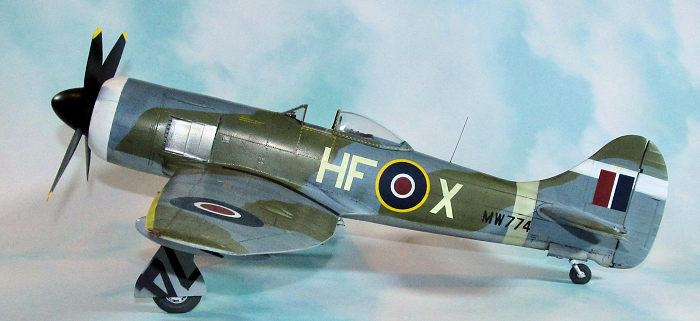 uld
find replacements for the smaller letters, but who makes 1/32 scale 24” or 36”
RAF lettering?) I've never had any issues with Special Hobby Decals before so it
was quite surprising that this happened. There was a happy ending to this
problem when I lucked out doing a search on Hannants and found/bought a mask set
by Maketar that provided masks for the black underwing ID codes for this
particular kit.
uld
find replacements for the smaller letters, but who makes 1/32 scale 24” or 36”
RAF lettering?) I've never had any issues with Special Hobby Decals before so it
was quite surprising that this happened. There was a happy ending to this
problem when I lucked out doing a search on Hannants and found/bought a mask set
by Maketar that provided masks for the black underwing ID codes for this
particular kit.
A month later, I had the masks and used them. They are made from Japanese Style Kabuki tape so they are easy to use or leave residue on the paint. They worked out once I got the placement right as I had to paint the gear doors at the same time as the wings which made things a bit complicated for me (the gear doors didn't fit perfectly in the wheel wells so there were gaps which allowed black paint to seep thru and required some touch ups later.) The rest of the stencils were added, but I had no issues.
All the decals used Microset and Microsol solution. A couple of the more stubborn ones used Solvaset.
For weathering, I went with my watercolor wash because I didn't want to make the plane look dirty, just a bit used. Watercolor is more subtle (I think) than oil paints, but is way more fragile. I used a 2:1 burnt umber/black watercolor mix with a drop of dish soap to break up the surface tension. I spread it around using a flat wide brush but unlike in the past, I let it dry for 15 minutes instead of a couple of hours and then wiped off the excess using slightly damp Q-tips. The underside and engine areas were a touch more dirty, but not too much more. I let the wash dry overnight before spraying on Tamiya flatcoat to seal everything in.
| FINAL CONSTRUCTION |
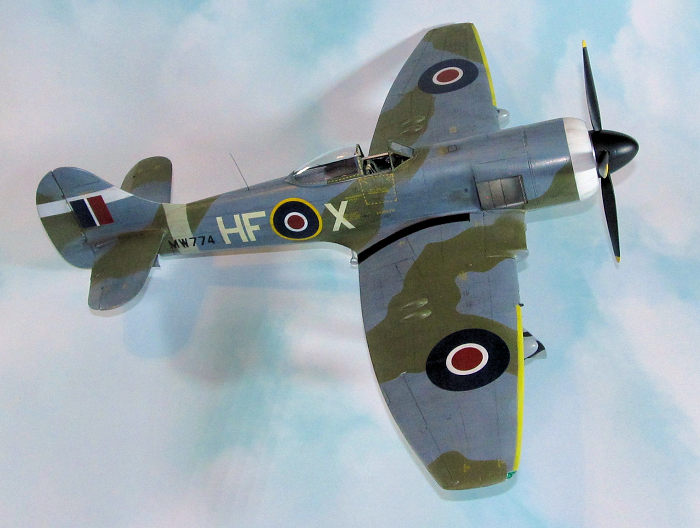 The
undercarriage is quite complicated and proved to be a giant pain in the
rear. I missed the simplicity of WW2 US landing gear which is much simpler
than Hawker ones with the tangle of retraction struts and various
outriggers. It really isn't Special Hobby's fault as the Tempest landing
gear is quite complex in real life (the smaller 1/48 scale makes things
easier to ignore where 1/32 scale makes them into more obvious headaches.)
The wheels had been primed and painted earlier so I just drilled out the
holes and glued them in place using CA glue.
The
undercarriage is quite complicated and proved to be a giant pain in the
rear. I missed the simplicity of WW2 US landing gear which is much simpler
than Hawker ones with the tangle of retraction struts and various
outriggers. It really isn't Special Hobby's fault as the Tempest landing
gear is quite complex in real life (the smaller 1/48 scale makes things
easier to ignore where 1/32 scale makes them into more obvious headaches.)
The wheels had been primed and painted earlier so I just drilled out the
holes and glued them in place using CA glue.
I ended up having to remove the portion of the fuselage decking behind the cockpit as it didn't fit as well as it should. I sanded down the edges till the decking could fit with minimal gaps. The gunsight and various other cockpit parts that fell out during construction were glued back in place.
Meanwhile I discovered the windscreen didn't fit as well as it should so I filled the gaps in with Perfect Plastic Putty (excess removed with dampened Q-Tips) and painted over again with Dark Green.
Next I added the prepainted hollow resin cannon nozzles and pitot tube were added (each held in place with a dab of CA glue.)
Lastly, I added the fuel tanks (which had been assembled and the holes in the wings were drilled out during main construction) but were painted and decaled at the end. The Tempest tanks have a clear attachment point with a visible seam that I could not get rid of so I just left it.
| CONCLUSIONS |
I am very happy with my radial engined Tempest Mk II which I prefer aesthetically over the inline Mark V. It was a lot of work to do, but I felt it was worth it. Be warned, this is a short run kit (a very nice one) and I found it took me a lot of work to get right. This kit is not for beginners at all. For the most experienced modellers or those who want a challenge. Finally, be prepared to make some shelf space for this model as in 1/32 scale it is quite bit (bigger than a 1/48 twin engined bomber.)
23 March 2021 Copyright
ModelingMadness.com. All rights reserved. If you would like your product reviewed fairly and fairly quickly, please
contact
the editor
or see other details in the
Note to
Contributors.